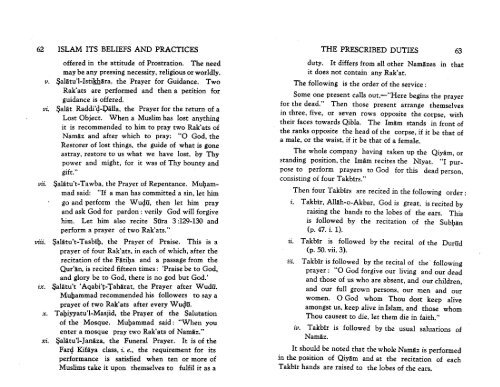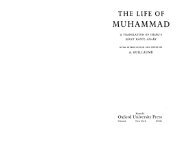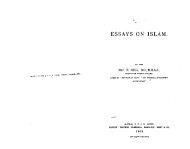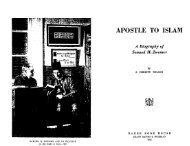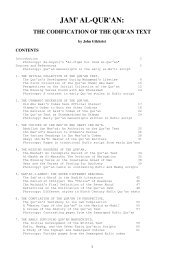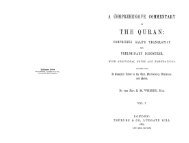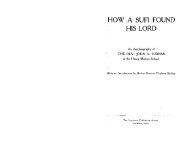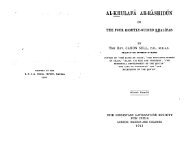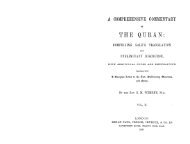Islam Its Belief and Practices - Radical Truth
Islam Its Belief and Practices - Radical Truth
Islam Its Belief and Practices - Radical Truth
Create successful ePaper yourself
Turn your PDF publications into a flip-book with our unique Google optimized e-Paper software.
62 ISLAM ITS BELIEFS AND PRACTICES THE PRESCRIBED DUTIES 63<br />
offered in the attitude of Prostration. The need<br />
may be any pressing necessity, religious or worldly.<br />
v. $aliitu'l-Istikhara, the Prayer for Guidance. Two<br />
Rak'ats are performed <strong>and</strong> then a petition for<br />
guidance is offered.<br />
vi. $aliit Raddi'q-l;>iilla, the Prayer for the return of a<br />
Lost Object. When a Muslim has lost anything<br />
it is recommended to him to pray two Rak'ats of<br />
Namiiz <strong>and</strong> after which to pray: "0 God, the<br />
Restorer of lost things, the guide of what is gone<br />
astray, restore to us what we have lost, by Thy<br />
power <strong>and</strong> might, for it was of Thy bounty <strong>and</strong><br />
gift."<br />
vii.<br />
$alatu't-Tawba, the Prayer of Repentance. Mu!;J.ammad<br />
said: "If a man has committed a sin, let him<br />
go <strong>and</strong> perform the Wuqu, then let him pray<br />
<strong>and</strong> ask God for pardon: verily God will forgive<br />
him. Let him also recite Sura 3 :129-130 <strong>and</strong><br />
perform a prayer of two Rak'ats."<br />
viii. $aliitu't-Tasbi!;J., the Prayer of Praise. This is a<br />
prayer of four Rak'ats, in each of which, after the<br />
recitation of the Fiiti!;J.a <strong>and</strong> a passage from the<br />
Qur'iin, is recited fifteen times: 'Praise be to God,.<br />
<strong>and</strong> glory be to God, there is no god but God.'<br />
ix. $aliitu't 'Aqabi't-Tahiirat, the Prayer after Wudu.<br />
Mu!;J.ammad recommended his followers to say a<br />
prayer of two Rak'ats after every W uqu.<br />
x. Ta!;J.iyyatu'I-Masjid, the Prayer of the Salutation<br />
of the Mosque. Mu!;J.ammad said: "When you<br />
enter a mosque pray two Rak'ats of Namiiz."<br />
xi. $aliitu'l-]aniiza, the Funeral Prayer. It is of the<br />
Farq Kifaya class, i. e., the requirement for its<br />
performance is satisfied when ten or more of<br />
Muslims take it upon themselves to fulfil it as a<br />
duty. It differs from all other Namiizes in that<br />
it does not contain any Rak'at.<br />
The following is the order of the service:<br />
Some one present calls out,-"Here begins the prayer<br />
for the dead." Then those present arrange themselves<br />
in three, five, or seven rows opposite the corpse, with<br />
their faces towards Qibla. The Imam st<strong>and</strong>s in front of<br />
the ranks opposite the head of the corpse, if it be that of<br />
a male, or the waist, if it be that of a female.<br />
The whole company having taken up the Qiyiim, or<br />
st<strong>and</strong>ing position, the Imam recites the Niyat. "I purpose<br />
to perform prayers to God for this dead person,<br />
consisting of four Takbirs."<br />
Then four Takbirs are recited in the following order:<br />
i. Takbir, Alliih-o-Akbar, God is great, is recited by<br />
raising the h<strong>and</strong>s to the lobes of the ears. This<br />
is followed by the recitation of the Subhiin<br />
(p. 47. i. 1). .<br />
ii. Takbir is followed by the recital of the Durud<br />
(p. 50. vii. 3).<br />
iii.<br />
Takbir is followed by the recital of the· following<br />
prayer: "0 God forgive our living <strong>and</strong> our dead<br />
<strong>and</strong> those of us who are absent, <strong>and</strong> our children,<br />
<strong>and</strong> our full grown persons, our men <strong>and</strong> our<br />
women. 0 God whom Thou dost keep alive<br />
amongst us, keep alive in <strong>Islam</strong>, <strong>and</strong> those whom<br />
Thou causest to die, let them die in faith."<br />
iv. Takbir is followed by the usual saluations of<br />
Namaz.<br />
It should be noted that the whole Namiiz is performed<br />
in the position of QiYiim <strong>and</strong> at the recitation of each<br />
Takbir h<strong>and</strong>s are raised to the lobes of the ears.


